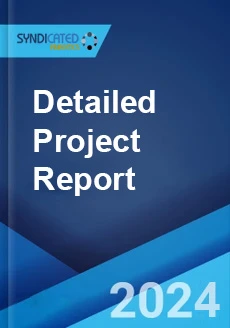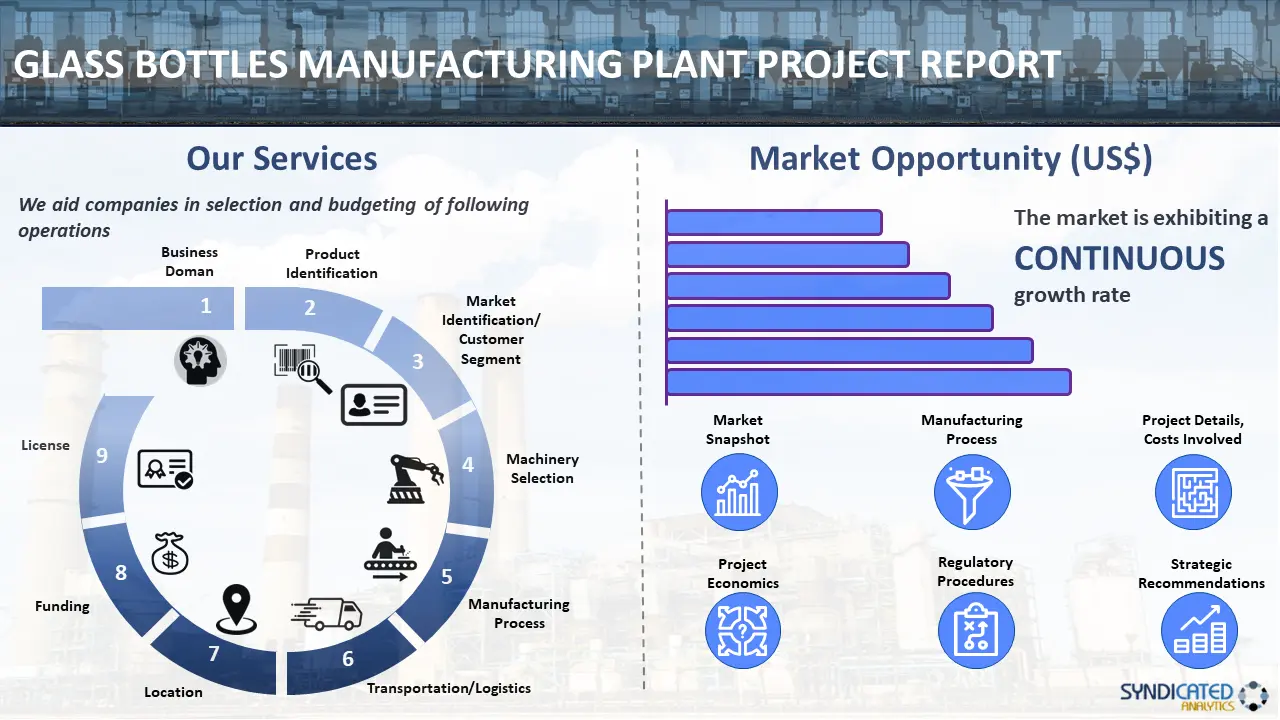
Glass Bottles Manufacturing Plant Project Report 2025 Edition
Report Coverage: Industry Analysis (Market Performance, Segments, Price Analysis, Outlook), Detailed Process Flow (Product Overview, Unit Operations, Raw Materials, Quality Assurance), Requirements and Cost (Machinery, Raw Materials, Packaging, Transportation, Utility, Human Resource), Project Economics (Capital Investments, Operating Costs, Profit Projections, Financial Analysis, Revenue), and Investment Opportunities
Report Overview:
Syndicated Analytics report, titled “Glass Bottles Manufacturing Plant Project Report 2025 Edition: Industry Analysis (Market Performance, Segments, Price Analysis, Outlook), Detailed Process Flow (Product Overview, Unit Operations, Raw Materials, Quality Assurance), Requirements and Cost (Machinery, Raw Materials, Packaging, Transportation, Utility, Human Resource), Project Economics (Capital Investments, Operating Costs, Profit Projections, Financial Analysis, Revenue), and Investment Opportunities,” provides a complete roadmap for setting up a glass bottles manufacturing plant. It covers a comprehensive market overview to micro-level information such as unit operations involved, raw material requirements, utility requirements, infrastructure requirements, machinery and technology requirements, manpower requirements, packaging requirements, transportation requirements, etc. The report provides detailed insights into project economics, including capital investments, project funding, operating expenses, income and expenditure projections, fixed costs vs. variable costs, direct and indirect costs, expected ROI and net present value (NPV), profit and loss account, financial analysis, etc. This report is a must-read for entrepreneurs, investors, researchers, consultants, and business strategists with a stake in the glass bottles industry. It provides an in-depth analysis of the industry's current state and future potential, offering valuable insights for decision-making and strategy development. The report is an indispensable resource that offers a detailed examination of the glass bottles industry. It is a valuable tool for anyone seeking to establish a foothold in this dynamic sector.

Glass bottles refer to versatile packaging solutions that are widely used across numerous industries for their durability, impermeability, and inert nature. They are manufactured from a mixture of silica sand, soda ash, and limestone. They are formed into various shapes and sizes, catering to a range of products, from beverages to pharmaceuticals. These bottles come in multiple types, including clear, amber, and colored glass, each serving a specific purpose. Clear glass bottles are preferred for showcasing the product. In contrast, amber or colored glass protects from light, making it ideal for storing light-sensitive substances such as beer or certain medications. The key advantages of glass bottles include their non-reactive nature, ensuring no chemical interaction with the contents, and their recyclability, making them an eco-friendly packaging option. They are also valued for their premium look and feel, often associated with high-quality products. This blend of functionality, aesthetic appeal, and environmental friendliness makes glass bottles a favored choice in the packaging industry.
Market Trends/Drivers:
The global market is majorly driven by a growing preference for sustainable and high-quality packaging solutions. The food and beverage industry, particularly the wine, beer, and spirits sector, remains a significant driver of demand, as glass bottles are preferred for preserving flavor and extending shelf life. Additionally, the perception of glass as a more premium and safer packaging option compared to plastics, especially in light of increasing environmental concerns, is providing a boost to its popularity among consumers and manufacturers. Along with this, the pharmaceutical industry's reliance on glass bottles for storing sensitive medications adds another dimension to the market's growth. Glass's inert properties make it ideal for ensuring the stability and safety of pharmaceutical products.
In addition, the rising awareness of the environmental impact of packaging materials is leading to a greater emphasis on recycling and the circular economy, which benefits the glass bottle market due to the material's recyclability. Moreover, the increasing demand for sustainable packaging solutions is driving the market, as glass bottles align with environmental goals and consumer expectations. Apart from this, innovations in glass bottle manufacturing aimed at reducing weight while maintaining strength are enhancing their appeal, particularly in industries where transportation costs are a concern. Another factor influencing the market is the evolving landscape of food and beverage consumption patterns, including the rise in craft beverages and artisanal products. These sectors often prefer glass packaging for its premium appeal and preservation qualities. Furthermore, the cosmetic and personal care industry's growing preference for glass packaging, due to its perceived luxury and purity, is contributing to the market. Some of the other factors driving the market include continuous innovation, environmental considerations, and shifting consumer behaviors.
The project report covers the following aspects of the glass bottles market:
- Market Snapshot:
- Market Performance
- Market Breakup by Segment
- Market Breakup by Region
- Price Trends
- Impact of COVID-19
- Market Outlook
- Manufacturing Process:
- Product Overview
- Detailed Process Flow
- Unit Operations Involved
- Mass Balance and Raw Material Requirements
- Project Details, Requirements and Costs Involved:
- Land, Location and Site Development
- Plant Layout
- Machinery Requirements and Expenditures
- Raw Material Requirements and Expenditures
- Packaging Requirements and Expenditures
- Transportation Requirements and Expenditures
- Utility Requirements and Expenditures
- Manpower Requirements and Expenditures
- Project Economics
- Capital Investments
- Operating Costs
- Expenditure Projections
- Revenue Projections
- Profit Projections
- Financial Analysis
- Regulatory Procedures and Approval
- Key Success and Risk Factors
Report Scope:
| Report Features | Details |
|---|---|
| Product Name | Glass Bottles |
| Report Coverage | Detailed Process Flow: Unit Operations Involved, Quality Assurance Criteria, Technical Tests, Mass Balance, and Raw Material Requirements Land, Location and Site Development: Selection Criteria and Significance, Location Analysis, Project Planning and Phasing of Development, Environmental Impact, Land Requirement and Costs Plant Layout: Importance and Essentials, Layout, Factors Influencing Layout Plant Machinery: Machinery Requirements, Machinery Costs, Machinery Suppliers (Provided on Request) Raw Materials: Raw Material Requirements, Raw Material Details and Procurement, Raw Material Costs, Raw Material Suppliers (Provided on Request) Packaging: Packaging Requirements, Packaging Material Details and Procurement, Packaging Costs, Packaging Material Suppliers (Provided on Request) Other Requirements and Costs: Transportation Requirements and Costs, Utility Requirements and Costs, Energy Requirements and Costs, Water Requirements and Costs, Human Resource Requirements and Costs Project Economics: Capital Costs, Techno-Economic Parameters, Income Projections, Expenditure Projections, Product Pricing and Margins, Taxation, Depreciation Financial Analysis: Liquidity Analysis, Profitability Analysis, Payback Period, Net Present Value, Internal Rate of Return, Profit and Loss Account, Uncertainty Analysis, Sensitivity Analysis, Economic Analysis Other Analysis Covered in The Report: Market Trends and Analysis, Market Segmentation, Market Breakup by Region, Price Trends, Competitive Landscape, Regulatory Landscape, Strategic Recommendations, Case Study of a Successful Venture |
| Currency | US$ (Information can also be provided in the local currency) |
| Pricing and Purchase Options | Single User License: US$ 3450 Five User License: US$ 4450 Corporate User License: US$ 5450 |
| Customization Scope | The report can also be customized based on the requirement of the customer |
| Post-Sale Analyst Support | 12-14 Weeks |
| Delivery Format | PDF and Excel through email (We can also provide the editable version of the report in PPT/Word format on special request) |
Key Questions Answered in This Report?
- What are the key success and risk factors in the glass bottles industry?
- How has the glass bottles market performed so far and how will it perform in the coming years?
- What is the structure of the glass bottles industry and who are the key players?
- What are the various unit operations involved in a glass bottles manufacturing plant?
- What is the total size of land required for setting up a glass bottles manufacturing plant?
- What are the machinery requirements for setting up a glass bottles manufacturing plant?
- What are the raw material requirements for setting up a glass bottles manufacturing plant?
- What are the utility requirements for setting up a glass bottles manufacturing plant?
- What are the manpower requirements for setting up a glass bottles manufacturing plant?
- What are the infrastructure costs for setting up a glass bottles manufacturing plant?
- What are the capital costs for setting up a glass bottles manufacturing plant?
- What are the operating costs for setting up a glass bottles manufacturing plant?
- What should be the pricing mechanism of glass bottles?
- What will be the income and expenditures for a glass bottles manufacturing plant?
- What is the time required to break-even?
Need a Customized Project Report?
Although we have tried to make the report as comprehensive as possible, we believe that every stakeholder may have their specific requirements. In view of this, we can customize the report based on your particular needs. You can share your business requirements with our consultants, and we will provide you a tailored scope. Some of the common customizations that our clients request us include:
- The report can be customized based on the country/region that you plan to set up your plant.
- The manufacturing capacity of the plant can be customized based on your requirements.
- Machinery suppliers and costs can be customized based on your requirements.
- Any additions to the current scope can also be provided based on your requirements.
Why buy Syndicated Analytics reports?
-
Our reports provide stakeholders insights into the viability of a business venture, allowing them to take informed business decisions.
- We have a strong network of consultants and domain experts in 100+ countries across North America, Europe, Asia Pacific, South America, Africa, and the Middle East.
- We have a strong database of equipment and raw material suppliers across all major continents.
- We regularly track and update land costs, construction costs, Utility costs, labour costs, etc across 100+ countries around the globe
- We are the trusted business partners to the world’s leading corporates, governments, and institutions. Our client list ranges from small and start-up businesses to fortune 500 companies
- Our strong in-house team of engineers, statisticians, modelling experts, charted accountants, architects, etc. have been instrumental in building, expanding, and optimizing sustainable manufacturing plants across the globe.
Purchase Options
Ask For Customization
Personalize this research
Triangulate with your own data
Get data as per your format and definition
Gain a deeper dive on a specific application, geography, customer or competitor
Any level of personalization
Get in Touch
Call us on
US: +1-213-316-7435
Uk: +44-20-8040-3201
Drop us an email at
sales@syndicatedanalytics.com